Sophie Grigson: My eight favourite dishes of a lifetime
What would be your eight dream dishes of a lifetime? Chef, TV presenter and food writer Sophie Grigson shared hers with Toby Keel.

‘I’ve been here for three and a half years now, and it’s fab,' says chef and author Sophie Grigson, who decided, almost on a whim, to move to Puglia, the region of Southern Italy that makes up the 'heel of the boot' that you learned about in Geography lessons. And it's fair to say she has no regrets.
'It's the best move I ever made. In my life, actually!’
Sophie's new Italian life is at the heart of her new television show, Sophie Grigson: Slice of Italy, in which she talks about the food and drink of the region, and cooks some of the classic local dishes with her own twist.
Today, though, she's chatting to us about something a little different: her eight favourite dishes of a lifetime, the meals that she'd want to survive on if she were, say, shipwrecked on an island. And as you might expect of a true foodie, making the choice wasn't easy.
‘To be honest, if you’d asked me on a different day they might be totally different,' she says.
With that, and in Sophie's own words, on we go:
Orrechiete alle cime di rapa
This is dish that I really, really love — and which I didn’t know until moving to . Orrechiete are the little ear-shaped pasta, and cime di rapa is a kind of green, leafy vegetable, a little bit like purple sprouting broccoli but with a lot more leaf to it. It’s very slightly bitter — people in Puglia love that in their food. It is starting to be grown in England now, and you’ll sometimes see it called ‘turnip tops’.
Sign up for the Country Life Newsletter
Exquisite houses, the beauty of Nature, and how to get the most from your life, straight to your inbox.

This dish is simply pasta cooked with about a ton of this green vegetable, finished with a little bit of anchovy, garlic and chilli fried up in oil, then all tossed together — and it’s just so delicious. It’s a great winter comfort dish, but it also feels like you’re doing yourself some good as there are so many greens in it. Fantastic. Jump down to read Sophie's recipe for orrechiete alle cime di rapa.
Tiramisu
This choice might be a bit obvious, except it wasn’t for me. I’ve spent 30 years or more thinking I just didn’t like tiramisu, but I was asked by a client to make one as it was their favourite dish, so I went off and did some experimenting… and totally fell in love with it, so much so that now I’m slightly obsessive about it.
It does depend on the version; when it’s really good, it’s fabulous, but there’s an awful lot of bad tiramisu around. I’m on a mission with my friends here to find the best pizza and the best tiramisu in the area, and while we’ve had a lot of great pizza, there’s only been one tiramisu I’ve really liked.
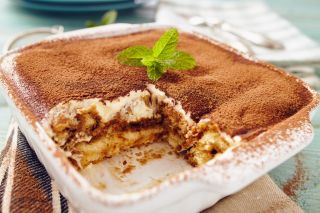
The key is the blend: some alcohol but not too much, and I like a big amount of the mascarpone mixture against the sponge fingers. I have to say the version I now make is bloody good. But one I had recently in a local café was beautiful, served with an amaro liqueur called San Marzano dribbled over the top. I might steal that concept!
Tarte Tatin
Another dessert, but unlike tiramisu this is one I’ve loved all my life. As a child I spent a lot of time in France in a place near where the Tatin sisters are said to have invented Tarte Tatin. When you get it really well done, with the apples caramelised and perfectly cooked all the way through, it’s just so tender and delicious. I’m not very keen on the restaurant versions where they use puff pastry on the top — or on the bottom as you serve it. I think really it should be made with a sweet, shortcrust pastry, giving it that crumbly pastry contrast with the apples. Oh, and it has to be crème fraîche with it; I don’t approve of serving it with ice cream. It’s just wrong!
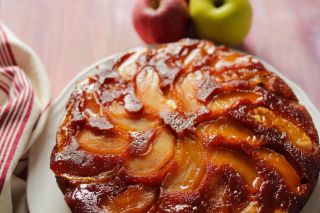
I’ve tried a few variations with different fruits and so on — but nothing quite hits the spot like the original with apples. I have to say that’s one thing I miss in Puglia — we have apples, obviously, but they have much less character and flavour than apples in the UK. A really good cox, or a russet, served with cheddar; how gorgeous is that?
Bangers and mash
Ooh, yes. With or without onion gravy is fine — I like it either way — and perhaps some lightly-blanched savoy cabbage on the side. What an amazing combination it , and it’s an amazingly democratic dish too. It doesn’t matter if you're rich or poor, working class or middle class, it’s an accessible dish and everybody loves it.

When people talk about typical British food they often mention roast beef, but I think bangers and mash should be the national dish, and it’s certainly something people eat a lot more often. Really good mash is hard to beat, and so easy to take for granted. On my new programme I made some for some Italian friends just as an accompaniment for a local meat dish, and they were all completely smitten by the mashed potato. They were besides themselves about it. They’re still talking about it now!
Pad Thai
One thing I really miss in the south of Italy is Asian food. I went back to London a couple of weeks ago and I think every meal I had was some sort of Asian food — Indian, Vietnamese, Thai — and it was fantastic. So I had to include something spicy in my top dishes, and I’ve gone for this.
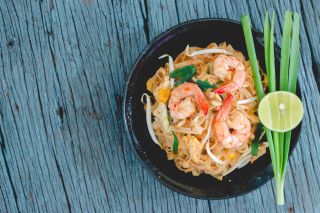
It has to be a really good Pad Thai: not overly sweet, lots of lime and coriander, prawns, and those gorgeous noodles that just slide down seductively. Hmm! That would make me very happy. I’ve been finding it tricky to make in Puglia as it’s hard to find decent coriander. I did start growing my own on the balcony until the cats decided it was a perfect place to sleep. So now I don’t have coriander, but I do have beautifully-scented cats.
Vietnamese summer rolls soft rice wraps
These I just absolutely adore. The prawns, bamboo shoots, the coriander and the hit of mint, all in a beautiful rice wrap. Served with a lovely dipping sauce they’re just so fresh and light. Here in Puglia when it’s hot they’re perfect as something that doesn’t need the oven to be on for ages. I’ve only been to Vietnam once, but I did my best to try everything in that time.
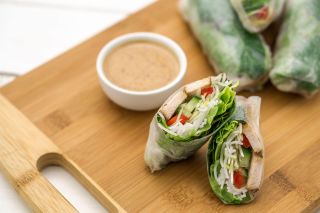
A lot of my love for the food comes from my time living in Oxford, and there was a wonderful restaurant around the corner from me run by two Vietnamese women. Sadly, one day it disappeared — a real shame, not least as they did a prawn and aubergine dish that I’ve never seen again since.
Spatchcock roast chicken
Roast chicken is always good, but a spatchcock chicken — cooked while opened out flat — is juicier, and you get more of a crisp skin as well, which I love. I roast it on a bed of vegetables, but I’m really not worried about which ones. Every time I do it I think I use a different mix, but I love adding new potatoes, wedges of onion, maybe some fennel, carrots, whatever, so that the vegetables at the bottom get bathed in chickeny juices.
I usually put something to baste it between the skin and the flesh. Some people don’t like doing that but I’m happy to; a bit of flavoured butter before roasting goes into the chicken, or sometimes . I’ve cooked spatchcock chickens in one way or another throughout my career — in fact they appear probably a little too often in my cookery books! You have to start with a good chicken, obviously, but that crisp skin on the outside and the moist flesh within… it’s just a wonderful thing.
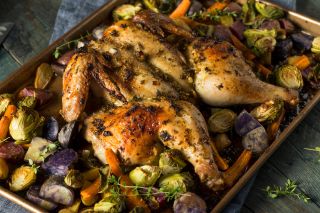
Strangely, in this part of Italy, chicken is rarely eaten, and you almost never see it on restaurant menus — I actually called my book The Curious Absence of Chickens. I’ve a brilliant local butcher who gets them in for me, but he doesn’t always have them. My neighbours eat pork, some lamb, beef… and horse and donkey. I’ve just found a different butcher in my town which sells donkey mortadella. It’s a conundrum for people coming from the UK where we hate the idea of eating donkey or horse, but here it’s seen as just another meat. That said, meat isn’t as big a part of the diet in Italy… except when it’s a special occasion, at which point they eat an absolute mountain of it. All done on the grill and, I have to say, usually overcooked...
Rice pudding
I’m going back to puddings again for my last one, but I struggled to make my mind up. Would it be chocolate mousse or rice pudding? I’ve gone for rice pudding, though, because I just love it, in any form — and there are so many forms of it.
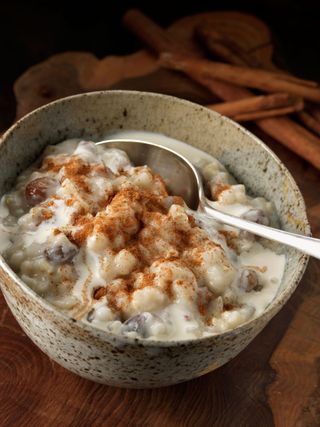
I love a classic British-style slow-cooked in the oven until the rice almost melts and there’s a lovely brown skin on the top, but I also like tinned rice pudding, Asian-style rice pudding with sticky rice and mango, or Middle Eastern ones that have spices, fruit and nuts in them. I even like school dinner rice pudding, with a dollop of jam in the middle. Always a dollop though, rather than swirled in — I’m not so much of a swirler inner. But I can take it in any form, cold or hot — I’m rice pudding groupie really.
And if you had to pick just one dish…?
Argh, this is impossible! I’ve reduced the choice down to either Pad Thai or the orrechiete alle cime di rapa. But I’ll go with the Pad Thai. It’s something you can vary, and you could eat it every day — it’d take a long time before I got heartily sick of it.
'Sophie Grigson: Slice of Italy' is aired at 9pm on Mondays on the Food Network. It's available to watch on catch-up via Discovery+. Her latest book, 'A Curious Absence of Chickens', also deals with her life in Italy, and is out now in Paperback.
Recipe: Orrechiete alle cime di rapa
From 'A Curious Absence of Chickens' by Sophie Grigson (published by Headline Home)
One of the truly great pasta dishes, for its taste and simplicity and economy. Pasta and greens are cooked together for maximum taste, then seasoned with brisk chilli, garlic and anchovy oil. The partial collapse of the greens is an essential component of the dish, so don’t fuss about over-cooking.
Cime di rapa (usually translated as turnip greens, but they’re not the same as the green leaves that come out of the top of a turnip) are a rarity outside of Italy, but purple sprouting broccoli is a decent stand-in.
Orecchiette alle Cime di Rapa is sometimes served with ‘poor man’s parmesan’, in other word crisp, golden fried breadcrumbs, but grated cheese is considered a no-no. Still, in the privacy of my kitchen, I break the rule with a sprinkle of freshly grated Pecorino or Parmesan. Try it without first, to taste it as it should be, then add as you will.
Ingredients
Serves 4
- 400g fresh orecchiette, or 350g dried orecchiette
- 800g cime di rapa, or leafy purple sprouting broccoli
- 3 cloves garlic, thinly sliced
- 2 fresh or dried red chillis, roughly chopped, seeds and all
- 6 tablespoons extra virgin olive oil
- 5 anchovies, chopped
- Salt
Method (using fresh orecchiette)
Put a large, well-salted pot of water on to boil. Rinse the cime di rapa thoroughly to get rid of inevitable grit (especially after heavy rainfall). Trim off the tougher thickest stalks and discard. Slash leaves and stems roughly into pieces 3 or 4 cms long. Precision is not required.
Toss them all into the boiling water, give them a stir, then simmer for around five minutes. Add the orecchiette, stir again, and cook for a final 2-3 minutes until the pasta is al dente.
As soon as the orecchiette are in the pan, put the oil, garlic and chillies and anchovy into a frying pan. Heat up and fry until the garlic is hinting at brown. Do not let the garlic burn.
By now the pasta and greens will be cooked. Scoop out a cup or ladleful of the pasta water and reserve. Drain swiftly and then tip into the frying pan.
Toss with the oil, chillis, garlic and anchovy and a slurp or two of pasta water until all are mixed and hot. Eat at once.
Method (with dried orecchiette)
The method is pretty much the same as above, except for timings. So, once your water is boiling add the orecchiette and the cime di rapa together.
Start heating the oil, chilli and garlic a couple of minutes before orecchiette and greens are ready, and finish as for fresh orecchiette.
Toby Keel is Country Life's Digital Director, and has been running the website and social media channels since 2016. A former sports journalist, he writes about property, cars, lifestyle, travel, nature.
-
 19 completely charming houses for sale across Britain, as seen in Country Life
19 completely charming houses for sale across Britain, as seen in Country LifeOur pick of the best homes to come to the market via Country Life in the last few days includes everything from a sprawling mansion in Kent to a charming Cornish cottage at under £500k.
By Toby Keel Published
-
 'They are inclined to bite and spray acid to protect territory': Meet the feisty red wood ant
'They are inclined to bite and spray acid to protect territory': Meet the feisty red wood antBy Ian Morton Published
-
 Kendal Mint Cake: The happy accident that fuelled the first ascent of Everest
Kendal Mint Cake: The happy accident that fuelled the first ascent of EverestWhat started out as a happy accident, went on to become the world’s best-travelled confectionery.
By Harry Pearson Published
-
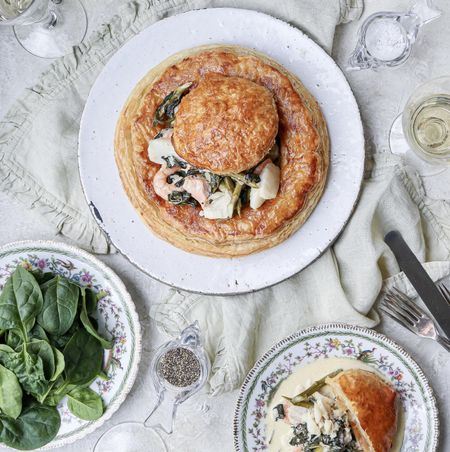 How to make an ethereal-sounding seafood, spinach and asparagus puff-pastry cloud
How to make an ethereal-sounding seafood, spinach and asparagus puff-pastry cloudOur Kitchen Garden Cook's recipe for a stuffed puff-pastry cloud is easier to make than it is to say.
By Melanie Johnson Published
-
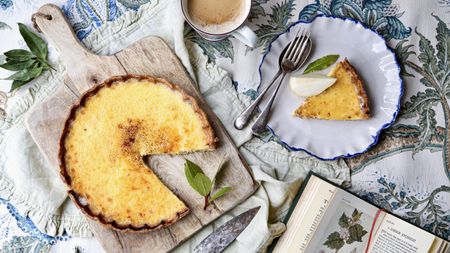 How to make a bay and vanilla crème brûlée custard tart
How to make a bay and vanilla crème brûlée custard tartElevate your everyday vanilla crème brûlée by infusing it with delicate bay.
By Melanie Johnson Published
-
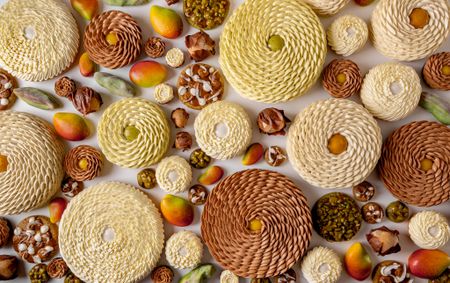 'Mary Berry has an aversion to a soggy cake bottom and I have one to a flaccid croissant': London's best baked goods by the people in the know
'Mary Berry has an aversion to a soggy cake bottom and I have one to a flaccid croissant': London's best baked goods by the people in the knowFrom high-end to humble, Swedish cinnamon bun to Greggs steak bake, London is an undisputed pantheon to the pastry. Illustrations by Bryony Fripp.
By Rosie Paterson Published
-
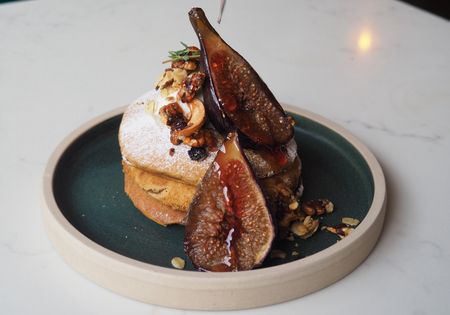 How to make the 'best pancakes in the universe'
How to make the 'best pancakes in the universe'When we sent writer Jo Rodgers to Oxfordshire to write up a Country Life guide, we were expecting her to wax lyrical about dreaming spires and Cotswolds villages. Instead, Jo came back raving about pumpkin pancakes — so we decided to track down the recipe.
By Country Life Published
-
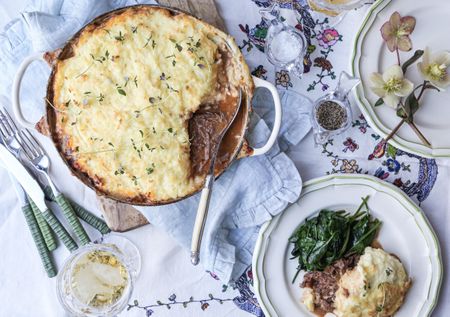 The greatest cottage pie recipe
The greatest cottage pie recipePotatoes are at the heart of so many favourite dishes, including this delicious cottage pie recipe that you will want to make again and again.
By Melanie Johnson Published
-
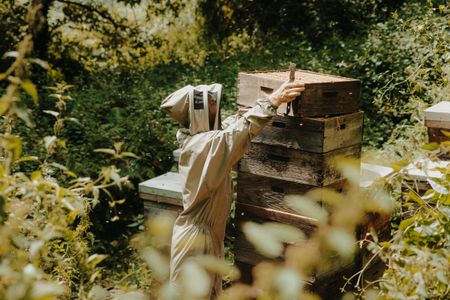 The need for mead: 'We can re-wild the countryside and get drunk while we’re doing it'
The need for mead: 'We can re-wild the countryside and get drunk while we’re doing it'The oldest alcoholic beverage in the world is in the midst of a renaissance.
By Amie Elizabeth White Published
-
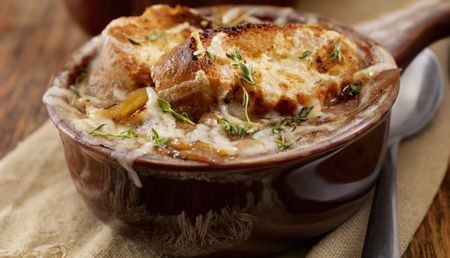 Tom Parker Bowles's favourite recipe: French onion soup
Tom Parker Bowles's favourite recipe: French onion soupThis dish is no mere Gallic broth, rather pure bonhomie in a bowl — a boozy, beefy, allium-scented masterpiece that cries out for the chill depths of winter
By Tom Parker Bowles Published

